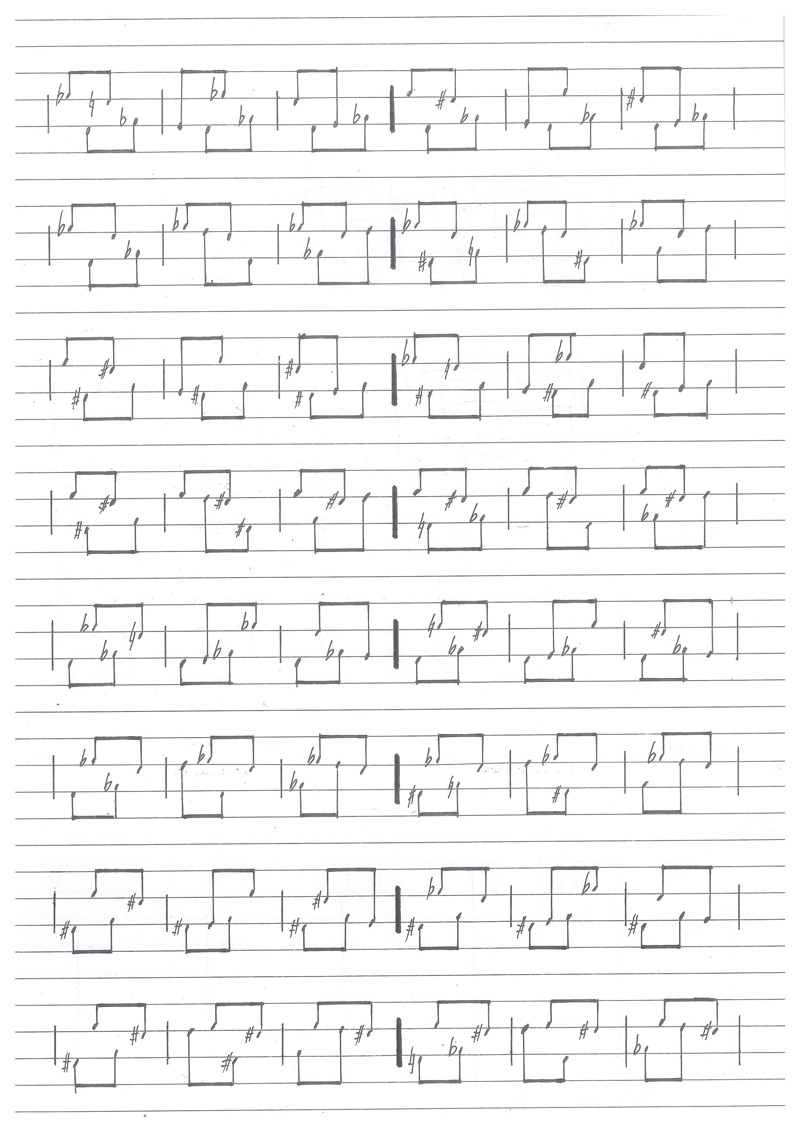Permanent Music for Vibraphone and Piano, 2023The parts contain the same material, but are shifted by a minor third. The notes are always arranged in minor and major seconds around two central notes that form a tritone interval: F and B for the piano, D and G# for the vibraphone. The motifs are always mirrored in the forms rake, inversion and inversion rake. Each player chooses and arranges their material freely from the given reservoir and proceeds at their own pace. The form must be created in real time and according to the given rules.I first used this structural principle in 2008 in Ordinary music Vol. 13. Originally, I developed it to simplify the notation because I could not read notes. I reduced the five-line staff to a single line around which I arranged the notes in whole and semitone intervals, so I could easily form mirror shapes due to the perfect symmetry of the notation system. When I transferred the material to a regular staff, I could transpose it to any pitch level, so that I could layer the parts at any intervals, depending on the number of instruments. In this piece, I developed the motifs from improvisation on the piano. I especially enjoyed creating chromatic clouds by circling the central notes while holding down the sustain pedal. By distributing the notes to different registers, I could loosen up the cluster structure and create a kind of illusory modality without a fundamental. When both instruments play together, a chromatic maelstrom is created whose wave structure can be shaded by grading the tempo and dynamic ratios. Recorded at OMA, October 2023, by David Pap. Piano: Nikolaus Gerszewski; vibraphone: Oliver Mayne. Permanent Music für Vibraphon und Klavier, 2023Die Stimmen enthalten dasselbe Material, sind aber um eine kleine Terz verschoben. Die Noten sind immer in kleinen und großen Sekunden um zwei zentrale Töne angeordnet, die ein Tritonusintervall bilden: F und B für das Klavier, D und G# für das Vibraphon. Die Motive werden immer in den Formen Krebs, Umkehrung und Umkehrungs-Krebs gespiegelt. Jeder Spieler wählt und arrangiert sein Material frei aus dem vorgegebenen Reservoir und geht dabei in seinem eigenen Tempo vor. Die Form muss in Echtzeit und nach den vorgegebenen Regeln gestaltet werden.Ich habe dieses Strukturprinzip erstmals 2008 in Ordinary music Vol. 13verwendet. Ursprünglich habe ich es entwickelt, um die Notation zu vereinfachen, weil ich keine Noten lesen konnte. Ich reduzierte die fünflinige Notenzeile auf eine einzige Linie, um die ich die Noten in Ganz- und Halbtonschritten anordnete, so dass ich aufgrund der perfekten Symmetrie des Notationssystems leicht Spiegelformen bilden konnte. Wenn ich das Material in eine reguläre Notation übertrug, konnte ich es auf jede beliebige Tonhöhe transponieren, so dass ich die Stimmen je nach Anzahl der Instrumente in beliebigen Intervallen schichten konnte. In diesem Stück habe ich die Motive aus der Improvisation auf dem Klavier entwickelt. Besonders gern habe ich chromatische Wolken erzeugt, indem ich die zentralen Noten umkreiste, während ich das Haltepedal gedrückt hielt. Wenn ich die Noten auf verschiedene Register verteilte, konnte ich die Clusterstruktur auflockern und eine Art illusorische Modalität ohne Grundton schaffen. Wenn beide Instrumente zusammen spielen, entsteht ein chromatischer Strudel, dessen Wellenstruktur durch Abstufung des Tempos und der dynamischen Verhältnisse schattiert werden kann. Aufgenommen im OMA, Oktober 2023, von David Pap. Klavier: Nikolaus Gerszewski; Vibraphon: Oliver Mayne. |
structure model  |